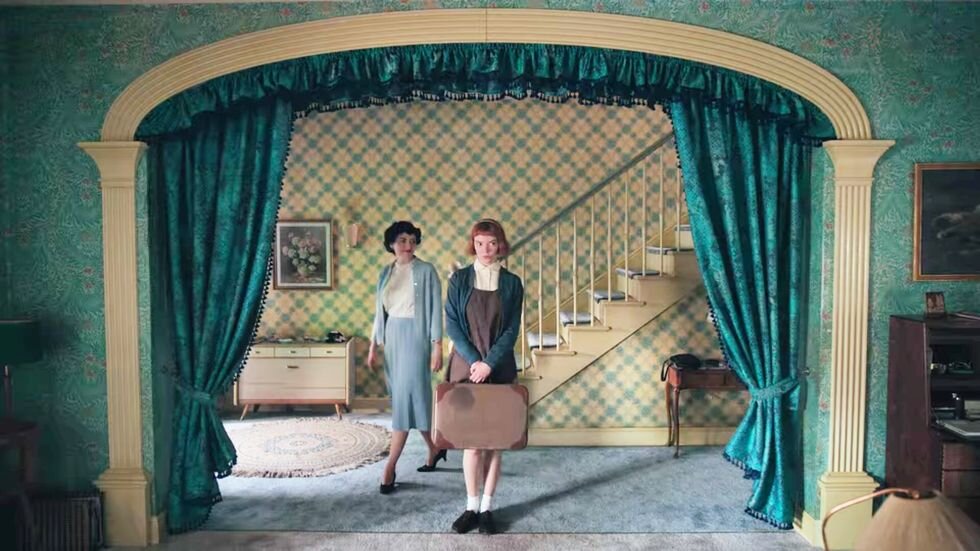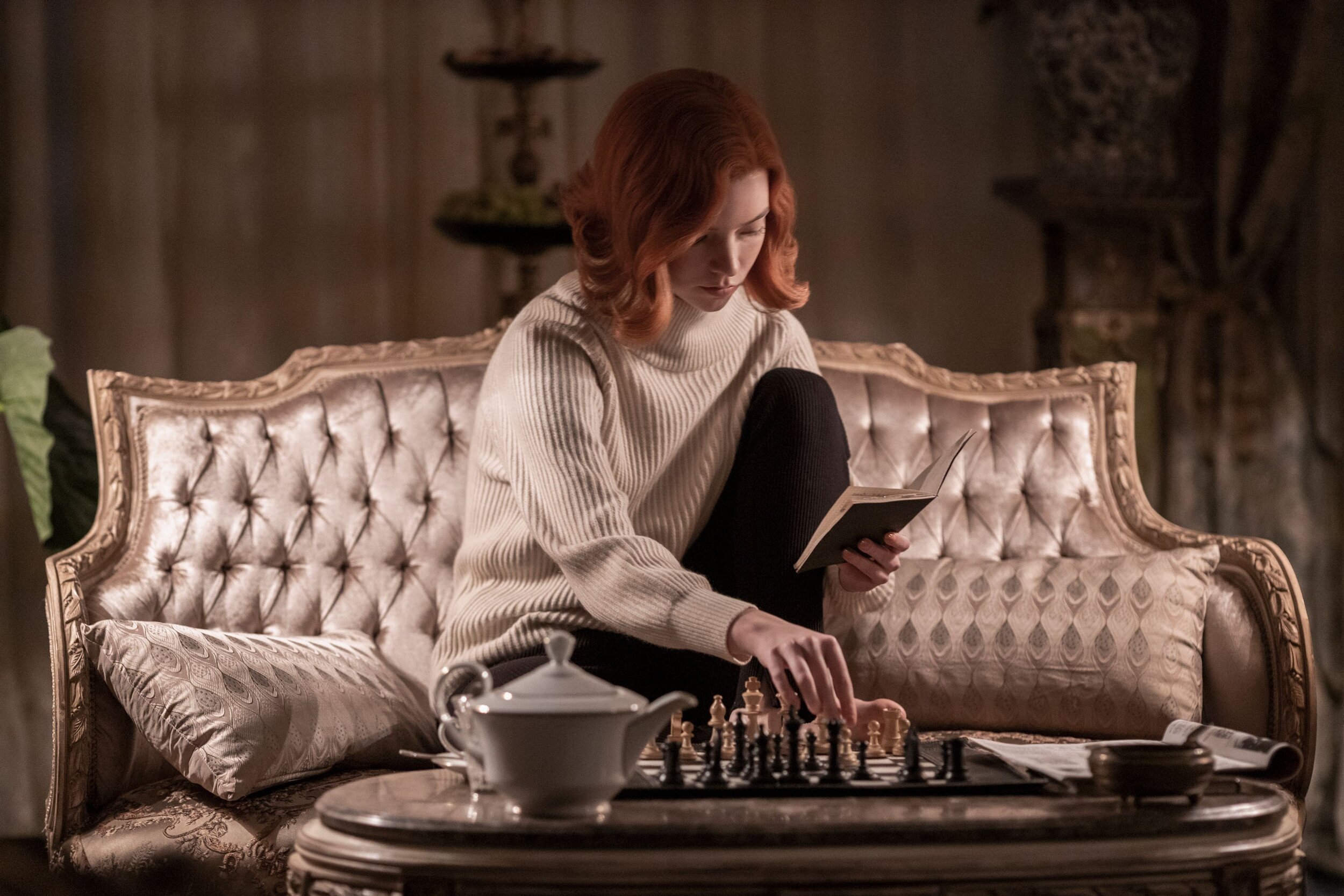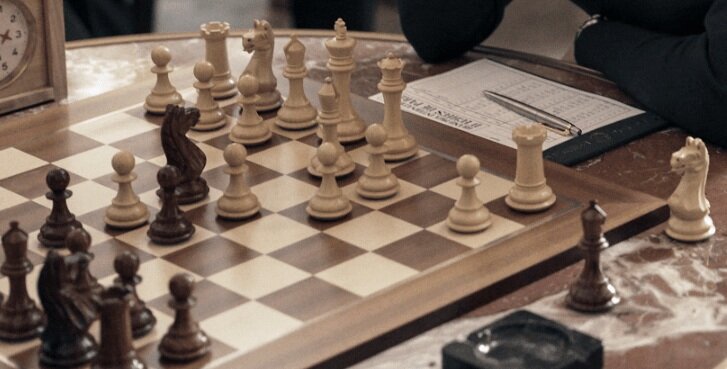Watching The Queen’s Gambit; on the Remarkable Unexceptionality of Beth Harmon
Netflix/Phil Bray.
‘With some people, chess is a pastime. With others, it is a compulsion, even an addiction. And every now and then, a person comes along for whom it is a birthright. Now and then, a small boy appears and dazzles us with his precocity, at what may be the world’s most difficult game. But what if that boy were a girl? A young, unsmiling girl, with brown eyes, red hair, and a dark blue dress? Into the male-dominated world of the nation’s top chess tournaments, strolls a teenage girl with bright, intense eyes, from Fairfield High School in Lexington, Kentucky. She is quiet, well-mannered, and out for blood.’
The preceding epigraph opens a fictional profile of Beth Harmon featured in the third episode of The Queen’s Gambit (2020), and is written and published after the protagonist — a teenage, rookie chess player, no less — beats a series of ranked pros to win her first of many tournaments. In the same deft manner as it depicts the character’s ascent to her global chess stardom, the piece also sets up the series’s narrative: this is evidence of a great talent, it tells us, a grandmaster in the making. As with most other stories about prodigies, this new entry into a timeworn genre is framed unexceptionally by its subject’s exceptionality.
Yet as far as tales regaled about young chess wunderkinds go, Beth Harmon’s stands out in more ways than one. That she is a girl in a male-dominated world has clearly not gone unremarked by both her diegetic and nondiegetic audiences. That her life has thus far — and despite her circumstances — been relatively uneventful, however, is what makes this show so remarkable. After all, much of our culture has undeniably primed us to expect the consequential from those whom we raise upon the pedestal of genius. As Harmon’s interviewer suggests in her conversation with Harmon for the latter’s profile, “Creativity and psychosis often go hand in hand. Or, for that matter, genius and madness.” So quickly do we attribute extraordinary accomplishments to similarly irregular origins that we presume an inexplicability of our geniuses: their idiosyncrasies are warranted, their bad behaviours are excused, and deep into their biographies we dig to excavate the enigmatic anomalies behind their gifts. Through our myths of exceptionality, we make the slightest aberrations into metonyms for brilliance.
Domino Magazine/Ulli Hanisch.
Nonetheless, for all her sullenness, non-conformity, and her plethora of addictions, Beth Harmon seems an uncommonly normal girl. No doubt this may be a contentious view, as evinced perhaps by the chorus of viewers and reviewers alike who have already begun to brand the character a Mary Sue. Writing on the series for the LA Review of Books, for instance, Aaron Bady construes The Queen’s Gambit as “the tragedy of Bobby Fischer [made] into a feminist fantasy, a superhero story.” In the same vein, Jane Hu also laments in her astute critique of the Cold War-era drama its flagrant and saccharine wish-fulfillment tendencies. “The show gets to have it both ways,” she observes, “a beautiful heroine who leans into the edge of near self-destruction, but never entirely, because of all the male friends she makes along the way.” Sexual difference is here reconstituted as the unbridgeable chasm that divides the US from the Soviet Union, whereas the mutual friendliness shared between Harmon and her male chess opponents becomes a utopic revision of history. Should one follow Hu’s evaluation of the series as a period drama, then the retroactive ascription of a recognisably socialist collaborative ethos to Harmon and her compatriots is a contrived one indeed.
Accordingly, both Hu and Bady conclude that the series grants us depthless emotional satisfaction at the costly expense of realism: its all-too-easy resolutions swiftly sidestep any nascent hint of overwhelming tension; its resulting calm betrays our desire for reprieve. Underlying these arguments is the fundamental assumption that the unembellished truth should also be an inconvenient one, but why must we always demand difficulty from those we deem noteworthy? Summing up the show’s conspicuous penchant for conflict-avoidance, Bady writes that:
over and over again, the show strongly suggests — through a variety of genre and narrative cues — that something bad is about to happen. And then … it just doesn’t. An orphan is sent to a gothic orphanage and the staff … are benign. She meets a creepy, taciturn old man in the basement … and he teaches her chess and loans her money. She is adopted by a dysfunctional family and the mother … takes care of her. She goes to a chess tournament and midway through a crucial game she gets her first period and … another girl helps her, who she rebuffs, and she is fine anyway. She wins games, defeating older male players, and … they respect and welcome her, selflessly helping her. The foster father comes back and …she has the money to buy him off. She gets entangled in cold war politics and … decides not to be.
In short, everything that could go wrong … simply does not go wrong.
Netflix/Phil Bray.
Time and again predicaments arise in Harmon’s narrative, but at each point, she is helped fortuitously by the people around her. In turn, the character is allowed to move through the series with the restrained unflappability of a sleepwalker, as if unaffected by the drama of her life. Of course, this is not to say that she fails to encounter any obstacle on her way to celebrity and success — for neither her childhood trauma nor her substance-laden adolescence are exactly rosy portraits of idyll — but only that such challenges seem so easily ironed out by that they hardly register as true adversity. In other words, the show takes us repeatedly to the brink of what could become a life-altering crisis but refuses to indulge our taste for the spectacle that follows. Skipping over the Aristotelian climax, it shields us from the height of suspense, and without much struggle or effort on the viewers’ part, hands us our payoff. Consequently lacking the epochal weight of plot, little feels deserved in Harmon’s story.
In his study of eschatological fictions, The Sense of an Ending, Frank Kermode would associate such a predilection for catastrophes with our abiding fear of disorder. Seeing as time, as he argues, is “purely successive [and] disorganised,” we can only reach to the fictive concords of plot to make sense of our experiences. Endings in particular serve as the teleological objective towards which humanity projects our existence, so we hold paradigms of apocalypse closely to ourselves to restore significance to our lives. It probably comes as no surprise then that in a year of chaos and relentless disaster — not to mention the present era of extreme precariousness, doomscrolling, and the 24/7 news cycle, all of which have irrevocably attuned us to the dreadful expectation of “the worst thing to come” — we find ourselves eyeing Harmon’s good fortune with such scepticism. Surely, we imagine, something has to have happened to the character for her in order to justify her immense consequence. But just as children are adopted each day into loving families and chess tournaments play out regularly without much strife, so too can Harmon maintain low-grade dysfunctional relationships with her typically flawed family and friends.
In any case, although “it seems to be a condition attaching to the exercise of thinking about the future that one should assume one's own time to stand in extraordinary relation to it,” not all orphans have to face Dickensian fates and not all geniuses have to be so tortured (Kermode). The fact remains that the vagaries of our existence are beyond perfect reason, and any attempt at thinking otherwise, while vital, may be naive. Contrary to most critics’ contentions, it is hence not The Queen’s Gambit’s subversions of form but its continued reach towards the same that holds up for viewers such a comforting promise of coherence. The show comes closest to disappointing us as a result when it eschews melodrama for the straightforward. Surprised by the ease and randomness of Harmon’s life, it is not difficult for one to wonder, four or five episodes into the show, what it is all for; one could even begin to empathise with Hu’s description of the series as mere “fodder for beauty.”
Neflix/Phil Bray.
Watching over the series now with Bady’s recap of it in mind, however, I am reminded oddly not of the prestige and historical dramas to which the series is frequently compared, but the low-stakes, slice-of-life cartoons that had peppered my childhood. Defined by the prosaicness of its settings, the genre punctuates the life’s mundanity with brief moments of marvel to accentuate the curious in the ordinary. In these shows, kindergarteners fix the troubles of adults with their hilarious playground antics, while time-traveling robot cats and toddler scientists alike are confronted with the woes of chores. Likewise, we find in The Queen’s Gambit a comparable glimpse of the quotidian framed by its protagonist’s quirks. Certainly, little about the Netflix series’ visual and narrative features would identify it as a slice-of-life serial, but there remains some merit, I believe, in watching it as such. For, if there is anything to be gained from plots wherein nothing is introduced that cannot be resolved in an episode or ten, it is not just what Bady calls the “drowsy comfort” of satisfaction — of knowing that things will be alright, or at the very least, that they will not be terrible. Rather, it is the sense that we are not yet so estranged from ourselves, and that both life and familiarity persists even in the most extraordinary of circumstances.
Perhaps some might find such a tendency towards the normal questionable, yet when all the world is on fire and everyone clambers for acclaim, it is ultimately the ongoingness of everyday life for which one yearns. As Harmon’s childhood friend, Jolene, tells her when she is once again about to fall off the wagon, “You’ve been the best at what you do for so long, you don’t even know what it’s like for the rest of us.” For so long, and especially over the past year, we have catastrophized the myriad crises in which we’re living that we often overlook the minor details and habits that nonetheless sustain us. To inhabit the congruence of both the remarkable and its opposite in the singular figure of Beth Harmon is therefore to be reminded of the possibility of being outstanding without being exceptional — that is, to not make an exception of oneself despite one’s situation — and to let oneself be drawn back, however placid or insignificant it may be, into the unassuming hum of dailiness. It is in this way of living that one lives on, minute by minute, day by day, against the looming fear and anxiety that seek to suspend our plodding regular existence. It is also in this way that I will soon be turning the page on the last few months in anticipation of what is to come.
Netflix/Phil Bray.
Born and raised in the perpetually summery tropics — that is, Singapore — Rachel Tay wishes she could say her life was just like a still from Call Me By Your Name: tanned boys, peaches, and all. Unfortunately, the only resemblance that her life bears to the film comes in the form of books, albeit ones read in the comfort of air-conditioned cafés, and not the pool, for the heat is sweltering and the humidity unbearable. A fervent turtleneck-wearer and an unrepentant hot coffee-addict, she is thus the ideal self-parodying Literature student, and the complete anti-thesis to tropical life.















The shows, films, and Netflix binges we’re spending our time with this autumn.